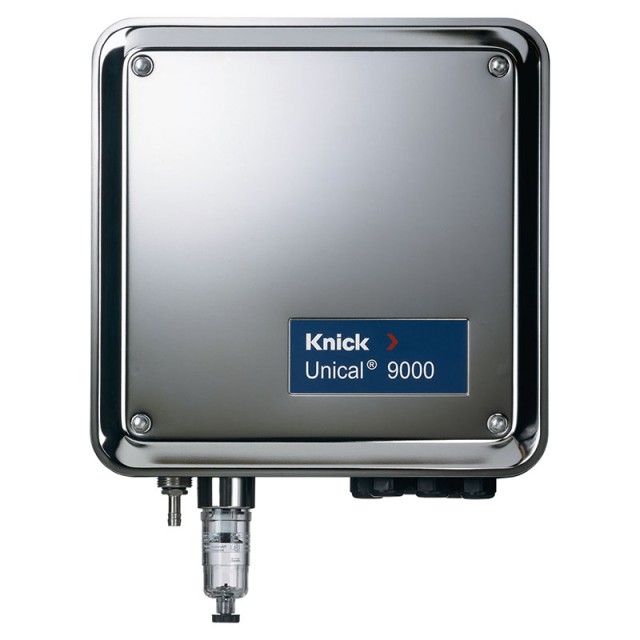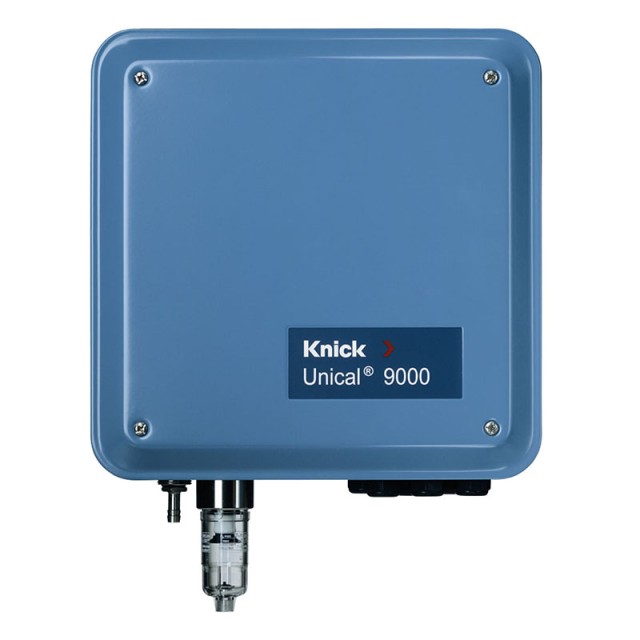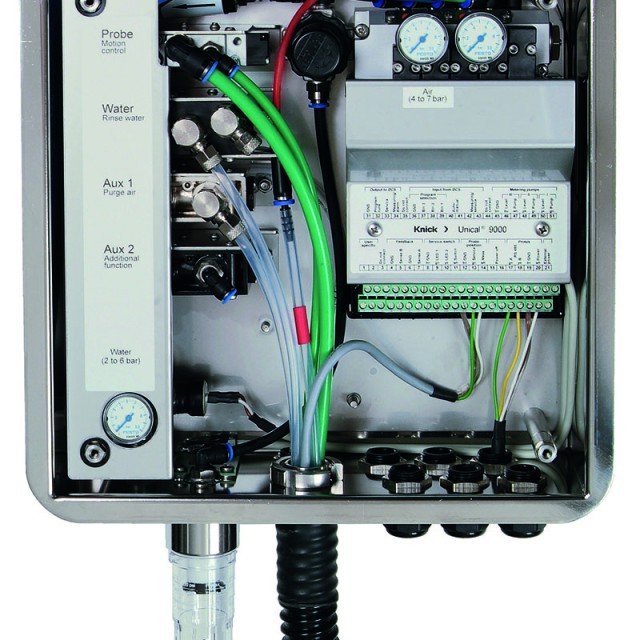
Hints and tips
Automatic cleaning and calibration of pH sensors in process measurement
In process pH measurement, we often encounter a problem where relatively frequent pH sensor maintenance is required. Unfortunately, when handling the sensor, it happens to be damaged. In order to avoid it and to make more frequent maintenance without human intervention, it is possible to invest in technology to create a system that will ensure:
- Automatic measurement
- Automatic sensor cleaning without human intervention
- Automatic calibration
- Replace sensor without shutting down
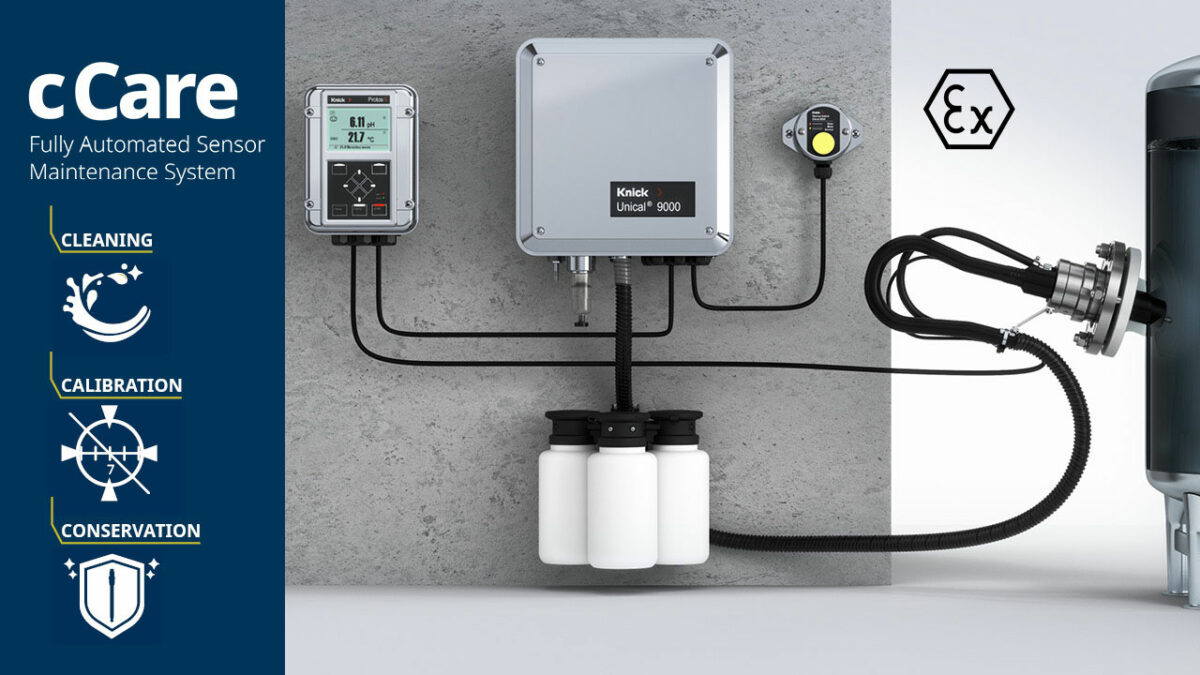
Such a system can be built with Knick's innovative solution. This solution is based on a set consisting of:
- Intelligent Protos converter
- Automatic pull-out fitting Ceramat or Sensogate
- Unical 9000 system
- Sensor Memosens
The system can be installed directly in operation, both in a safe environment and in a potentially explosive atmosphere. The fittings can be placed both directly into the pipeline and into the reactor. The connections can be different, starting with the standard flange with Variline special connections.
pH measurement
 The pH Measurement
The pH Measurement
The determination of the pH values is based on the principle of the potentiometric measurement - the measurement of electrical voltage. A pH electrode consists of two electrodes (pH glass membrane and reference) that are combined into one device in a combination pH electrode. Between these two electrodes a voltage is measured. The pH membrane of the electrode is made of special glass that is impermeable and electrically isolated. This glass (pH glass) forms a hydrated layer in water and responds selectively to hydrogen ions (H+). Sodium ions (Na+) of the glass are replaced by hydrogen ions (H+), which causes a change in free energy and an electrical potential that the pH meter measures. The amount of Na+ and H+ exchange across the pH glass depends strongly on the pH of the solution. The higher the pH the less hydrogen ions are in the solution, therefore less sodium ions are replaced across the pH glass. The liquid inside the pH glass is a buffer solution with a known and constant hydrogen ion concentration. Depending on the difference in pH between the inner buffer and the measuring solution a galvanic voltage is going to be produced between the inner and the outer layer of the pH glass. This voltage is measured by two Ag/AgCl electrodes. one electrode is located in the inner buffer the other in the reference electrolyte. Most pH electrodes have a nearly linear behavior in the measuring range of pH 0 to 14. Taking advantage of this behavior a pH electrode is calibrated between two different well known pH values, for example pH 4.01 and 7.00. Between those two values a linear extrapolation and also a linear interpolation is conducted.
Can you trust your buffer solution?
GMP, GLP, ISO 9001, EN 45000, Calibration, Verification, Traceability, and Certification from an accredited organization: Key words those are increasingly important. The calibration of pH and Redox electrodes has never been easy. All calibration procedures assume that the labelled values of the calibration buffers are correct. But buffer values can change over time and so can your results
A complete range of patented buffer solutions provides never before achieved pH stability. Hamilton guarantees DURACAL pH buffers for 5 years after the date of manufacture. The pH 9.21 and pH 10.01 buffers are even stable in air. See the diagram below for details. High buffering capacity provides rapid, stable calibration. Preservatives are added to prevent microbial and mold growth.
Traceability
An important issue for the production of Certified Reference Material is to ensure the traceability through an unbroken chain of comparisons to reference material of the highest metrological quality (Primary Reference Material).
- Closed Loop Traceability: Unlike other manufacturers where only a top-down traceability is applied, Hamilton is working with circular or closed loop traceability. The closed loop traceability ensures the users of Hamilton DURACAL buffer a unique reliability!
- Top-down traceability: At Hamilton, the pH value of DURACAL buffers is determined by comparison against two Secondary Reference Buffer Solutions. These are purchased from accredited suppliers for Secondary Reference Materials. The solutions themselves are compared against Primary Reference Solutions from PTB1) or NIST 2).
- Bottom-up traceability: To ensure the highest possible accuracy and full reliability of the pH value, a representative number of samples from every single production lot is sent to a German DKD3) laboratory (DKD-K-06901) for an external, independent and impartial verification. In this laboratory, the DURACAL samples are compared against Secondary Reference Solutions from DKD-K-06901.
The Secondary Reference Solutions are of course compared against Primary Reference Solutions from PTB. At this stage, the loop is closed: the PTB Primary Reference Solution is the starting and ending point of the traceability loop. DKD provides Hamilton with a calibration certificate for every DURACAL production lot.
Cleaning & reconditioning pH electrodes
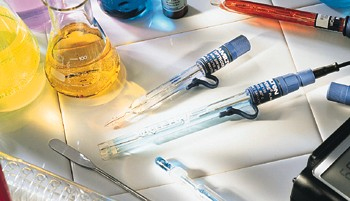 Often the pH meters are used in applications, which require regular cleaning of the electrode. These applications involve very hard waters, dirty samples like soil slurries, viscous materials or samples with high oil and protein content. We do not recommend these procedures for persons unfamiliar with or unable to use safe techniques involving these chemicals: Detergents, HCl (Hydrochloric Acid), and NaOH (Sodium Hydroxide).
Often the pH meters are used in applications, which require regular cleaning of the electrode. These applications involve very hard waters, dirty samples like soil slurries, viscous materials or samples with high oil and protein content. We do not recommend these procedures for persons unfamiliar with or unable to use safe techniques involving these chemicals: Detergents, HCl (Hydrochloric Acid), and NaOH (Sodium Hydroxide).
 Method 1
Method 1
Soak the electrode in a 0.4 molar concentration of HCl (hydrochloric acid) for 10 minutes, then rinse the electrode with deionized or distilled water. This should remove any organic protein from the glass electrode and the surface of the reference electrode.
Method 2
Soak the electrode in a 3.8 or 4.0 molar KCl (potassium chloride) solution heated to 50°C for 1 hour. Allow the KCl solution to cool down to room temperature, then rinse the electrode with deionized or distilled water. This will open and clean the reference electrode of all contaminants.
Method 3
Soak the electrode in a 4.01 pH buffer solution (EC-BU-4BT), heated to 50°C for 1 hour. Allow the buffer to cool down to room temperature, then rinse the electrode with deionized or distilled water. This will open and clean the reference electrode.
Method 4
After each use, rinse the electrode in 0.5 N or 1% HCl. If you have a build-up of oil or protein contaminants, try soaking the electrode in warm detergent and water solution. Degreasing dishwashing detergents or stain removing pre wash pretreatment are ideal for this: any brand will do. An overnight soak may be needed if build-up is heavy. Then rinse the pH sensor in deionized or distilled water and soak for 10 minutes in 1% HCl. Rinse the pH sensor in deionized or distilled water and check in buffers. If the pH sensor calibrates to buffers it can be used in tests. When the pH electrode cannot be calibrated even after attempts to clean it, it must be replaced.
Method 5
For protein removal, soak the pH electrode in contact lens enzymatic cleaner solution overnight. The enzymes will remove proteins from glass and plastic.
pH electrode maintenance
 Maintenance and storage of pH electrodes
Maintenance and storage of pH electrodes
pH electrodes are delicate sensors that require proper care and maintenance to produce accurate and reliable results, and to prolong useful life. When the pH electrode is not used for a period of time, always keep it moist. Store the pH electrode in storage solution or in a pH 7 buffer. DO NOT store the electrode in distilled or deionised water as this will cause ions to leach out of the glass bulb and reference eledtrolyte, causing slow and sluggish response.
pH electrodes may be shipped with either protective caps or in electrode soaking bottles to prevent cracking or scratching, and to keep the glass bulbs moist. Remove the electrode gently from the storage bottle and rinsse it with distilled water before use. For long-term storage, always keep the pH electrode in the bottle, filled with sufficient storage solution to cover the glass bulb. Replenish the bottle as needed.
- Pokaż wszystko

TCF 120 SUPER touch screen colour display. 8 programs of 8 steps each one. Unlimited data memory with USB port and USB stick.
Dostępność: na zapytanieNa życzenie
ICF 400 SUPER touch screen colour display. 8 programs of 8 steps each one. Unlimited data memory with USB port and USB stick.
Dostępność: na zapytanieNa życzenie
TCN 200 SUPER touch screen colour display. 8 programs of 8 steps each one. Unlimited data memory with USB port and USB stick.
Dostępność: na zapytanieNa życzenie





 0
0
 0
0